
“I couldn’t see straight or think straight. I was a fat-headed guy, full of pain.” — Cary Grant to Ingrid Bergman
In many ways, Notorious is the quintessential Alfred Hitchcock film. Besides being meticulously made, as are all his films, whether great, good or ghastly (yes, even he made a few of the latter!), and being one of the two best films of the 1940s (the other being Shadow of a Doubt), Notorious reflects many of the master’s themes and phobias, executed with a style and sophistication he had never reached before. Far from a minor ingredient, it brings together for the first time two of the era’s most fascinating screen personalities, [intlink id=”719″ type=”category”]Ingrid Bergman[/intlink] and [intlink id=”448″ type=”category”]Cary Grant[/intlink], who would be reunited in Indiscreet sixteen years later.
First and foremost in Notorious is the recurrence of Hitchcock’s frequent theme of drink (a late silent film was even called Champagne), for Alicia Huberman (Bergman) is an alcoholic and T. R. Devlin (Grant) a provider of booze. There is also non-alcoholic drink—orange juice to relieve Alicia’s hangover and, as a poison, coffee, which gives her another kind of hangover. Glasses, coffee cups and especially bottles of wine are frequently seen in tight close-ups.
Then there is one of the director’s favorite motifs, food as linked to sex, most subtly illustrated in Psycho, the scene in the motel when the already enamored Anthony Perkins serves [intlink id=”827″ type=”category”]Janet Leigh[/intlink] a sandwich, and carried to the ultimate in Frenzy when Barry Foster’s talk of food precedes his rape and murder of Barbara Leigh-Hunt, Hitch’s most violent and, to some, most tasteless indulgence. In Notorious, the food link is represented, primarily, by the chicken dinner Alicia prepares for Devlin on a Miami balcony.
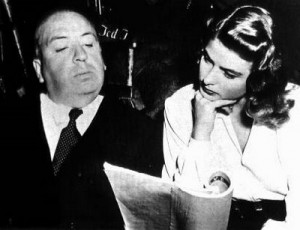
Another major theme so familiar to Hitch watchers, once again prominent in Notorious, is the mother-dominated son, exemplified earlier in Shadow of a Doubt and later in Strangers on a Train, North by Northwest, Psycho and The Birds. The son in Notorious is submissive to the mother just as the taciturn Devlin is intimidated by the over-expressive, free-living Alicia. Maybe, even, the Grant figure is afraid of women, as he facetiously says at one point—the opposite of the son, who is warm and free with his avowed love for Alicia. Interestingly, in Marnie, it is a daughter who is dominated by a controlling mother. The mother/son fixation, like so much in the Englishman’s films, comes from his own life, his ambivalent feelings about his own mother, especially now so soon after her death in 1942.
In Notorious, Hitchcock further expands the mother/son idea by incorporating another recurring motif, that of pairs, twins, the double, the doppelgänger. Besides the two sets of schemers (the Nazis and the American agents), here the pair of mother and son is complemented by the pair of lovers, Alicia and Devlin themselves.
A quarter into the film, Alicia’s father dies and this lifts a burden. “You see,” she says, “I don’t have to hate him any more—or myself.” The burden is lifted only partially because she often refers to him, illuminating another Hitchcock motif, how the dead influence the living. For think of the dead wife in Rebecca, how she haunts everyone at Manderley, and, back again to Psycho, Perkins who becomes his dead mother.
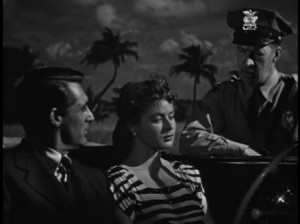 Another of Hitch’s phobias—the fear of the intimidating policeman—is one of the first topics Alicia mentions at the party which opens the film. Unique for a leading man’s introduction, Grant is first shown from the back as a speechless silhouette. Later, when the two are out for a wild night drive, they are pulled over by a motorcycle cop, reprised later with Janet Leigh in Psycho, with David Wayne in “One More Mile to Go,” an Alfred Hitchcock Presents TV episode, and, still later, with Patrick O’Neal in “Blueprint for Murder,” a kind of Hitchcock homage in a Columbo installment.
Another of Hitch’s phobias—the fear of the intimidating policeman—is one of the first topics Alicia mentions at the party which opens the film. Unique for a leading man’s introduction, Grant is first shown from the back as a speechless silhouette. Later, when the two are out for a wild night drive, they are pulled over by a motorcycle cop, reprised later with Janet Leigh in Psycho, with David Wayne in “One More Mile to Go,” an Alfred Hitchcock Presents TV episode, and, still later, with Patrick O’Neal in “Blueprint for Murder,” a kind of Hitchcock homage in a Columbo installment.
In The Wrong Man, the director would fully expose his fear of jails and policemen. Whether true or not, Hitch always told the story that, as a little boy, when he had done something wrong, his father took him to the local jail and had the police lock him in a cell for a few minutes. “That’s what we do,” he said, “to naughty little boys.”
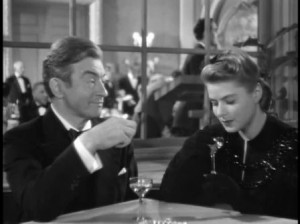 The plot of Notorious, simply put, is this: Following World War II, an American agent, Devlin, convinces a loose, alcoholic woman to become a spy in Rio de Janeiro. (In a logical world, away from film fantasy, not a safe security risk, would one say?) She is to ingratiate herself with the leader of a Nazi coven, a man, Alex Sebastian ([intlink id=”604″ type=”category”]Claude Rains[/intlink]), who was once in love with her. When he proposes marriage, she is encouraged to accept by the American contact (Louis Calhern) and the seemingly distant Devlin.
The plot of Notorious, simply put, is this: Following World War II, an American agent, Devlin, convinces a loose, alcoholic woman to become a spy in Rio de Janeiro. (In a logical world, away from film fantasy, not a safe security risk, would one say?) She is to ingratiate herself with the leader of a Nazi coven, a man, Alex Sebastian ([intlink id=”604″ type=”category”]Claude Rains[/intlink]), who was once in love with her. When he proposes marriage, she is encouraged to accept by the American contact (Louis Calhern) and the seemingly distant Devlin.
After a house guest of Sebastian’s makes a fuss over a wine bottle at dinner, Devlin suggests Alicia persuade Sebastian, now her husband, to throw a “big shindig.” Devlin invites himself and, with the wine cellar key Alicia had slipped off Sebastian’s key chain, he discovers that some of the wine bottles contain uranium ore. (This is another example of Hitch’s famous MacGuffin: the uranium is only a peg to hang a tale; the movie is about the lovers.) In his exploring, however, Devlin breaks a bottle.
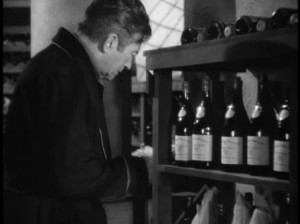 Sebastian is suspicious when the missing cellar key reappears on his key chain and descends to the wine vault. There he finds bottle fragments and realizes he’s married to an American agent, and that his Nazi cohorts won’t permit his betrayal. The way he awakens his mother to tell her reflects Hitch’s own childhood, when he would report to his mother at the foot of her bed. Sebastian’s mother (Leopoldine Konstantin) suggests his fellow Nazis need never know—that Alicia must be done away with. Slowly.
Sebastian is suspicious when the missing cellar key reappears on his key chain and descends to the wine vault. There he finds bottle fragments and realizes he’s married to an American agent, and that his Nazi cohorts won’t permit his betrayal. The way he awakens his mother to tell her reflects Hitch’s own childhood, when he would report to his mother at the foot of her bed. Sebastian’s mother (Leopoldine Konstantin) suggests his fellow Nazis need never know—that Alicia must be done away with. Slowly.
After Alicia realizes her coffee is being poisoned, she is sequestered in her bedroom, the phone removed. Devlin returns to the Sebastian mansion and finds her almost unconscious in bed. With a concealed gun to coerce mother and son in front of the watching Nazis, Devlin helps her down the staircase toward the front door. Once Alicia, with Sebastian’s help, is safely in a waiting car, Devlin locks the door and leaves Sebastian alone at the base of the front steps. Silhouetted in the house doorway, the waiting Nazis ask to see him. Sebastian climbs the stairs and the giant door closes behind him.
The first of five or six of Hitch’s masterful camera shots occurs in the scene where Alicia, in bed, is recovering from the previous night’s binge. She watches as Devlin leans askew against a doorway, then enters the room. Ted Tetzlaff’s camera shows the glass, full-screen, then, still from her viewpoint, it follows Devlin, now upside down, then askew again, then right side up, as he approaches her bed.
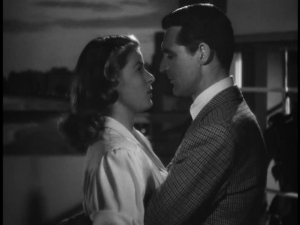 The next Hitchcock camera tour de force appears during that chicken dinner Alicia is preparing. From the balcony through the living room to the phone, Bergman and Grant stroll together, embraced, kissing, nibbling at one another’s lips and ears and whispering sweet nothings. Hitch turns a limitation imposed by the Hays Office—that a single kiss could last only so long—into a masterful exercise in camera technique while, at the same time, doubling the romantic excitement.
The next Hitchcock camera tour de force appears during that chicken dinner Alicia is preparing. From the balcony through the living room to the phone, Bergman and Grant stroll together, embraced, kissing, nibbling at one another’s lips and ears and whispering sweet nothings. Hitch turns a limitation imposed by the Hays Office—that a single kiss could last only so long—into a masterful exercise in camera technique while, at the same time, doubling the romantic excitement.
Some artful, smooth camera moves, with ingenious cutting, are the hallmark of Alicia’s first arrival at the Sebastian mansion, a kind of Bleak House as it will prove. As with those awry shots from her bed, everything is seen from her viewpoint—the foyer, the staircase (it leads to the upstairs bedrooms of mother and son) and the library. Still as seen by Alicia/the camera, Sebastian’s mother descends the stairs, glides across the room and moves directly into a tight close-up. (The staircase is critical on several occasions in this film and central to its finale. A favorite device of German expressionism, staircases appear profusely in Hitchcock, as early as his third film, The Lodger in 1926.)
During Alicia’s arrival, there is soft piano music in the background, the “Chopin” section from Robert Schumann’s Carnaval. A piano is clearly seen but no pianist!
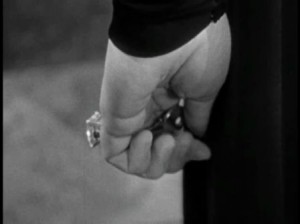 At the party the newly weds throw, there occurs the true tour de force camera move of the film, a regular spectacle, one of Hitch’s most famous. A slow, unbroken crane shot descends from on high, following the staircase down to the guests and Alicia on a checkerboard floor, suggestive of chess—the guests mere chess pieces—and the game being played. The camera descent ends in a tight close-up of the key in her nervous left hand.
At the party the newly weds throw, there occurs the true tour de force camera move of the film, a regular spectacle, one of Hitch’s most famous. A slow, unbroken crane shot descends from on high, following the staircase down to the guests and Alicia on a checkerboard floor, suggestive of chess—the guests mere chess pieces—and the game being played. The camera descent ends in a tight close-up of the key in her nervous left hand.
Later, during the long scene when Sebastian awakens his mother, a low camera hovers above his head, like the sword of Damocles. And when the drugged Alicia collapses at the foot of the staircase, the previous overhead shot that had descended to the hand holding the key is replaced, now by an ascending shot, her body and gown spread on the checkerboard floor like something out of a fashion magazine. This effect would be repeated in Karin Dor’s death in Topaz (1969).
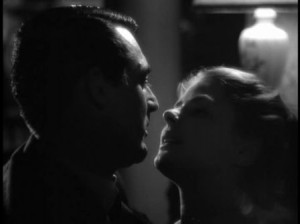 Throughout the film, Hitch’s affection for his favorite actress has already been shown in any number of close-ups and long, lingering shots. It’s only when Devlin comes to take her from the house and the two embrace on what could have been her deathbed that the camera unashamedly caresses, not Alicia now but Ingrid, revolving slowly around the couple. Bergman was nowhere more flatteringly photographed, not even by Arthur Edeson in Casablanca or Joseph Ruttenberg in Gaslight.
Throughout the film, Hitch’s affection for his favorite actress has already been shown in any number of close-ups and long, lingering shots. It’s only when Devlin comes to take her from the house and the two embrace on what could have been her deathbed that the camera unashamedly caresses, not Alicia now but Ingrid, revolving slowly around the couple. Bergman was nowhere more flatteringly photographed, not even by Arthur Edeson in Casablanca or Joseph Ruttenberg in Gaslight.
Unlike some directors who believe that the camera should be as inconspicuous as possible, Hitchcock is always rhapsodic, certainly creative, even extravagant, in his visual images, as Notorious repeatedly demonstrates. Hardly any Hitch film, including the silent ones, is without at least one camera stunt. Of the abundant ones in Notorious, the party crane shot and the pièce de résistance of the camera revolving around the two stars clearly draw the attention—gloriously.
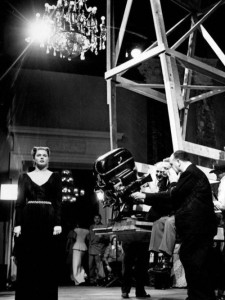 For a director who began his career in the silent era and who was strongly influenced by German expressionism—both highly befitting the visual—Hitchcock is intuitively concerned, equally so, with what one hears: dialogue, music and aural effects, be it rain, a scream, flapping feathers, a flushing toilet or a slamming door.
For a director who began his career in the silent era and who was strongly influenced by German expressionism—both highly befitting the visual—Hitchcock is intuitively concerned, equally so, with what one hears: dialogue, music and aural effects, be it rain, a scream, flapping feathers, a flushing toilet or a slamming door.
He was always in search of the ideal script and warred with those screen writers who fell short of his standards—Erle Stanley Gardner and MacKinlay Kantor, to name two—and in awe of those who rose to share his vision—Thornton Wilder, Samuel Taylor and Ernest Lehman. For, always, Hitch secretly wanted to be a writer. Although Hitch’s Oscar nominations for cinematography outnumber those for screenplay, to well illustrate his mastery of the visual, the nominations for Best Screenplay are Rebecca, Shadow of a Doubt, Lifeboat, Rear Window, North by Northwest—and Notorious, the work of Ben Hecht. A good basis for a late night parlor game, this comparison, but beware that an Academy Award is not necessarily a definitive gauge of anything.
And then there is the music, both source and the underlying score. Hitchcock was cognizant of the importance of music as an ingredient of the movie package. Like his search for the best writers and cameramen, he wanted the right composer for each individual kind of film. He was badly served in most of his early sound films, primarily due to the primitive state of that art at the time, and in a few of his later ones, due to weak composers and weak films.
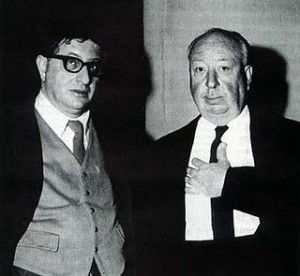 He was, for example, never fully satisfied with the four scores Dimitri Tiomkin wrote for him. And, as for the quartet of scores from Franz Waxman, only Rebecca is among that composer’s best. In Bernard Herrmann, however, Hitch found a worthy team member to share first-class honors alongside cameramen like Robert Burks and writers like Lehman. Further, no one was more of a kindred spirit than Herrmann. Both men had high artistic standards, a dark view of human nature and the sense that chaos could descend at any moment.
He was, for example, never fully satisfied with the four scores Dimitri Tiomkin wrote for him. And, as for the quartet of scores from Franz Waxman, only Rebecca is among that composer’s best. In Bernard Herrmann, however, Hitch found a worthy team member to share first-class honors alongside cameramen like Robert Burks and writers like Lehman. Further, no one was more of a kindred spirit than Herrmann. Both men had high artistic standards, a dark view of human nature and the sense that chaos could descend at any moment.
Being a connoisseur of fine wines and a sophisticated reader whose taste ranged from Henry James to Edgar Allan Poe to Franz Kafka to Charles Dickens, Hitchcock was equally conversant in a variety of music—jazz in Rich and Strange, dance hall in The 39 Steps and Miss Froy’s message tune in The Lady Vanishes. A big-name pop vocalists of the day, Doris Day sings “Que Sera Sera” in the remake of The Man Who Knew Too Much, which also includes highbrow Arthur Benjamin’s Storm Clouds cantata. In both Blackmail and Saboteur, there is Beethoven’s Fifth Symphony as well as the Schumann in Notorious. In Saboteur, the blind man Robert Cummings comes across plays Delius’ Summer Night on the River. Poulenc’s Mouvement perpetuel No. 1 is the basis for the Rope score and Tchaikovsky’s Francesca da Rimini is a non-dance piece used perversely as ballet music in Torn Curtain.
Hitch knew exactly what he wanted, with specifications of when music should be heard and when it shouldn’t be, and how the music should “go” with the screen. In Shadow of a Doubt, he asked Tiomkin to use Franz Lehár’s The Merry Widow waltz, symbol of Joseph Cotton as the Merry Widow murderer. Most famously, he first instructed Herrmann not to use music during the shower murder in Psycho; the director was counting on the sound of the water and Janet Leigh’s screams. But Herrmann suggested he watch the scene with music, strings only. Hitch changed his mind, and that one minute of film is arguably the director’s best known screen sequence.
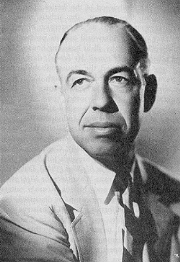 More specifically regarding Notorious, Hitch had the services of Roy Webb, his only “official” score for the director. Webb did a few cues for Spellbound and is rumored to have been the actual author of the Mr. and Mrs. Smith score, credited on screen to Edward Ward. Like Herrmann, Webb strove to support the psychological underpinnings of a film. Unlike Herrmann, however, he went about it more subtly, with thinner orchestral textures; he didn’t wish to compete with the screen, almost to the point of underplaying the drama, since he felt the other elements in the film are powerful on their own.
More specifically regarding Notorious, Hitch had the services of Roy Webb, his only “official” score for the director. Webb did a few cues for Spellbound and is rumored to have been the actual author of the Mr. and Mrs. Smith score, credited on screen to Edward Ward. Like Herrmann, Webb strove to support the psychological underpinnings of a film. Unlike Herrmann, however, he went about it more subtly, with thinner orchestral textures; he didn’t wish to compete with the screen, almost to the point of underplaying the drama, since he felt the other elements in the film are powerful on their own.
In establishing the scenario, Hitchcock wanted Brazilian music, since most of the story takes place in Rio de Janeiro. (Notorious was filmed entirely at RKO studios, for Gregg Toland and a crew had journeyed to Rio to photograph scenery for the numerous rear screen projections.) Brazilian dance music by Aloysia Oliveira and René Garriguenc appears both in the score itself and in source music, mainly at the big party.
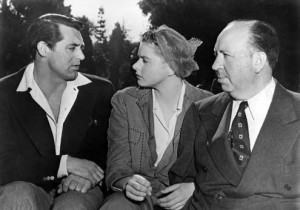 Webb’s main title opens with fateful trumpets. Next, a brief, hesitating transition precedes the love theme for Alicia and Devlin. It is romantically tuneful, saved from being “luscious” by the economy of the scoring—and vaguely sounding familiar from somewhere else. Anyway, the melody is attractive, with a dramatic rest at the top of its upward sweep, followed by a resonant, dipping close. A piano lends, again, a hesitating change and, like the trumpets, gives the music, now and later, an ominous accompaniment.
Webb’s main title opens with fateful trumpets. Next, a brief, hesitating transition precedes the love theme for Alicia and Devlin. It is romantically tuneful, saved from being “luscious” by the economy of the scoring—and vaguely sounding familiar from somewhere else. Anyway, the melody is attractive, with a dramatic rest at the top of its upward sweep, followed by a resonant, dipping close. A piano lends, again, a hesitating change and, like the trumpets, gives the music, now and later, an ominous accompaniment.
The best of Webb’s score comes toward the end of the film—Sebastian’s discovery of the missing key, his investigation of the cellar, his slow walk back upstairs to awaken his mother and his climb up those steps in the film’s last shot. Christopher Palmer, in his liner notes for Varèse Sarabande’s 1985 LP release of four Hitchcock soundtracks, including Notorious, writes more persuasively than I could how Webb closes the film. As Sebastian ascends those steps to confront the waiting Nazis, “ . . . the music swings eloquently to a close—like the huge front door—with an air of black and terrible finality.”
For possibly the best study of the undeservedly neglected Roy Webb, Palmer’s The Composer in Hollywood (1990), is highly recommended. In the last chapter (as I remember), Palmer relates his visits with the composer and shares his feelings about Webb’s hard and unfair obscurity. If anybody was the victim of a jinx, it was Webb. He not only experienced the death of his wife and a house fire that destroyed many of his scores, but illness and memory loss. He died in 2008 at the age of 94.
As for the Varèse Sarabande recording mentioned, it can be only marginally recommended. Although admirably recorded by Bruce Leek and Joe Gastwirt, and played well enough by the Utah Symphony under Charles Ketcham, even for an LP at the time it was barely respectable with a paltry thirty-eight minutes. Worse still, in its CD reincarnation no fillers have been added. Depends on how desperate the buyer is for, admitted, one of the few sources for what amounts to only a snippet of the Notorious score—not quite six minutes! Also on the disc are longer suites from two other hard-to-find scores, Tiomkin’s Strangers on a Train and Waxman’s Suspicion.
And as for the film itself, the definitive DVD version is, of course, the one from The Criterion Collection, though, still, the quality of the restoration isn’t consistent throughout—for one, sometimes too bright and lacking contrast—and there seems to be an excess of what would be called in those old LP days “surface noise.”
There are abundant extras, though the price tag is a bit stiff, as usual with Criterion. Perhaps the most valuable of the bonuses are the 1948 Lux Radio Theatre adaptation, Bergman now joined by Joseph Cotton in the Grant part, and the isolated score feature, which, beware, includes source music, sound effects and the long stretches of silence in between.
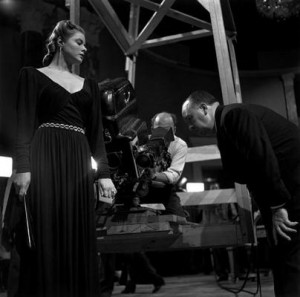 Commentaries are always a mixed bag—depending: some movie-watchers think they are indispensable, others ignore them altogether. How fortunate it would be to have Hitchcock thinking aloud about what motivated this and that—and, too, why reviewers and critics have been so wrong about all those fanciful analyses. Hitch, I’ve been told, was unavailable. As a second choice, there are two separate play-by-play pundits—either the academic Marian Keane, with the film’s psychology and psychosis laid bare, or the seemingly ever-present Rudy Behlmer, with saturating information, sometimes not always what is pertinent to the film.
Commentaries are always a mixed bag—depending: some movie-watchers think they are indispensable, others ignore them altogether. How fortunate it would be to have Hitchcock thinking aloud about what motivated this and that—and, too, why reviewers and critics have been so wrong about all those fanciful analyses. Hitch, I’ve been told, was unavailable. As a second choice, there are two separate play-by-play pundits—either the academic Marian Keane, with the film’s psychology and psychosis laid bare, or the seemingly ever-present Rudy Behlmer, with saturating information, sometimes not always what is pertinent to the film.
Or perhaps more wisely, forget all those features: just watch Notorious, maybe two or three times to absorb all that that old master Hitch has put on the screen.